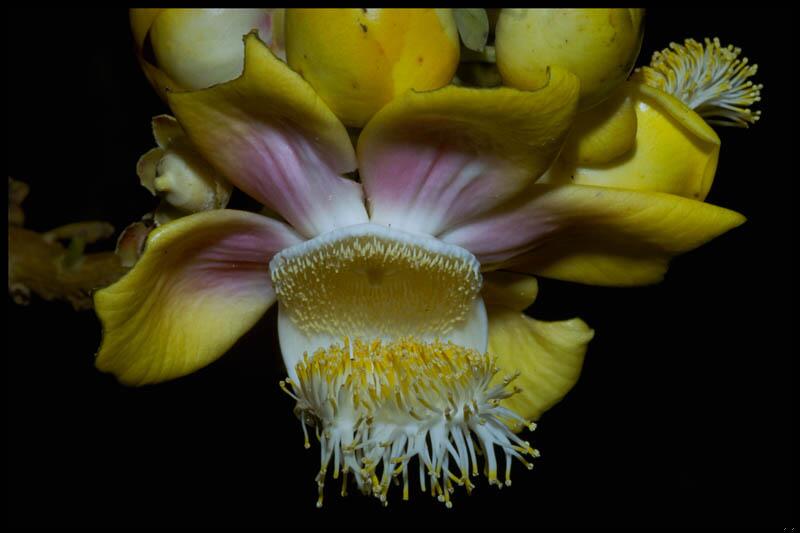Lecythidaceae
Couroupita Aubl.

Kingdom: Plantae Rank: Genus Parent: Lecythidaceae Status: Valid
Common Names:
- Ayuhama, cannon ball tree, bola de cañon - English, Peru
Taxonomic Classification
Classification: The three species of Couroupita can be distinguised by differences in the androecium. The fruits, however, are similar in all three species.
Morphological Description
Diagnosis: Leaves spirally arranged, clustered at the apices of twigs; flowers with the anthers of the hood sterile (producing fodder pollen); ovary 6-locular; fruits indehiscent, cannon-ball like, the pericarp relatively thin, often cracks open when fruits hit the ground; seeds embedded in a pulp not easily separated from the seed, the pulp oxidizes bluish-green when exposed to air, the testa pubescent; and embryo with leaf-like cotyledons.
Vegetative Morphology
Habit: Trees.
Leaves: Leaves spirally arranged, clustered at ends of stout twigs (5-7 mm diámetro); venation eucamptrodromous toward base, brochidodromous toward apex, the tertiary veins weakly percurrent.
Stipules: Stipules absent, at least in adult trees.
Exudate: Exudate absent.
Reproductive Morphology
Flowers: Flowers zygomorphic, 2-8 cm diameter; calyx not enclosed in bud, with 6 calyx-lobes; petals 6; flat at apices; androecium with flat hood or with hood invaginated (C. subsessilis), either with or without stamen free area between staminal ring and hood, the staminodes anther-bearing, with fodder pollen, the fertile stamens ca. 600 in staminal ring, the anthers of staminal ring <2 mm long, with lateral dehiscence; ovary 6-locular, the style erect.
Fruit: Fruits indehiscent, globose or nearly so, falling to ground with seeds inside at maturity.
Seeds: Seeds lenticular in cross section, embedded in and not easily removed from surrounding pulp, the pulp oxidizing bluish-green when exposed to air, without aril, sarcotesta, or wing, the testa pubescent, not boney; embryo with leaf-like cotyledons.
Other
Uses: Couroupita guianensis is planted as an ornamental and botanical curiosity in subtropical and tropical botanical gardens.
Distribution: Three spp. El Salvador, Honduras, Nicaragua, Panama, Colombia, Venezuela, Guyana, Surinam, French Guiana, Ecuador, Peru, and Brasil.
Ecology: Periodically flooded and non-flooded forests depending on the species.
Notes: See Couroupita guianensis for information about pollination and dispersal biology.